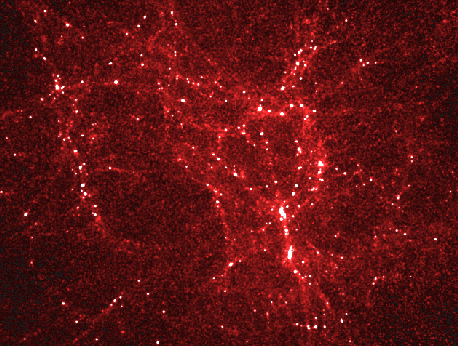
|
Credit & Copyright: F. Summers (Princeton),
D. Cox, R. Patterson, E. Wesselak, and B. Sanders
(NCSA),
L. Carpenter
(Pixar),
GC3,
Cosmic Voyage,
Smithsonian
Explanation:
What did our
universe look like when it was young? To answer this, cosmologists run
sophisticated
computer programs tracking the locations of
millions of particles. The
above
animated frame is the result of such a
calculation and shows how our
universe
might have looked when it was just a fracton of its current
age. The universe started out very smooth - matter
and light are spread almost uniformly. As time progressed,
gravity
caused slight gatherings of mass to accrete so that ever greater
conglomerations formed.
Galaxies and long
filaments
formed - which are shown by the bright patches and streaks in the
above
frame. An
IMAX movie including hundreds of these frames is currently under
production and should be released this summer.
|
January February March April May June July August September October November December |
| ||||||||||||||||||||||||||||||||||||||||||||||||
NASA Web Site Statements, Warnings, and Disclaimers
NASA Official: Jay Norris. Specific rights apply.
A service of: LHEA at NASA / GSFC
& Michigan Tech. U.
Based on Astronomy Picture
Of the Day
Publications with keywords: early universe
Publications with words: early universe
See also:
- APOD: 2024 June 24 Á JADES GS z14 0: A New Farthest Object
- HUDF Infrared: Dawn of the Galaxies
- GRB 090423: The Farthest Explosion Yet Measured
- Building Galaxies in the Early Universe
- Redshift 5.8: A New Farthest Quasar
- BOOMERANG Images The Early Universe
- Unexpected Galaxy String in the Early Universe
